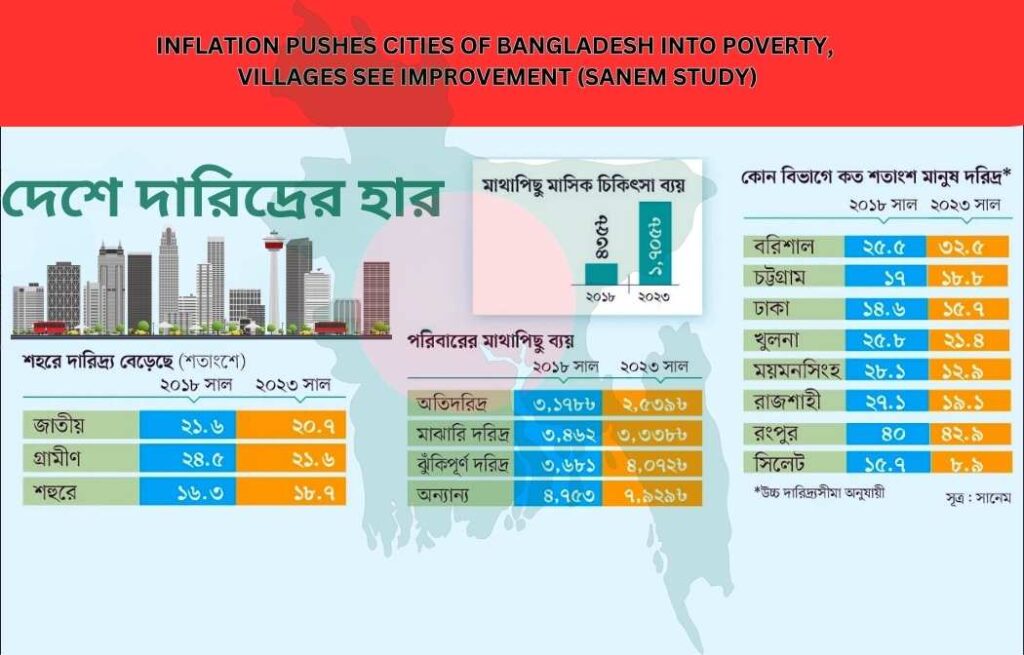Month after month high inflation has increased the poverty rate in urban areas. Income inequality has also increased. High inflation has forced most families to change their eating habits. Many households are at risk of food insecurity. But a new study by SANEM reveals a surprising twist: While inflation squeezes urban households, forcing them to cut back on food and essentials, rural areas are experiencing a decrease in poverty.

Breaking Down the Problem (Causes of Rising Urban Poverty):
The Grip of Inflation: Soaring inflation is the main culprit. Rising food and living costs are forcing urban families to tighten their belts, leading to:
- Food Insecurity: Many are skipping meals, opting for cheaper, less nutritious food.
- Cutbacks on Essentials: Healthcare, education, and even basic needs like clothing are taking a backseat.
- Increased Debt: With rising costs and stagnant incomes, many families are resorting to loans to make ends meet.
Such information has emerged in a research report titled ‘How the Corona Pandemic and Subsequent Disruptions are Impacting Poverty, Income Inequality, Education and Food Security in Bangladesh’. Private research organization South Asian Network on Economic Modeling (SANEM) and the Global Development Institute of the University of Manchester in the United Kingdom have done the research jointly.
When the economic recovery was underway after the shock of Corona, inflation rose. The country has been going through high inflation for a long time. It has affected poor people.
Salim Raihan, Executive Director, SANEM
Why are Cities Becoming Poorer and Villages Richer? Survey Reports
It is said that the poverty rate in urban areas was 16.3 percent in 2018. In 2023, it increased to 18.7 percent. At the same time, the rural poverty rate decreased from 24.5 percent to 21.6 percent.
SANEM-GED was surveyed in 2018 in 10,500 households across the country. Of these, 9,650 houses were surveyed again in October and November last year. SANEM sent the results of the research report prepared based on that survey to the media yesterday.
According to research reports, 70 percent of households or households have been forced to change their eating habits under the pressure of high inflation. Also, 35 percent of households have cut non-food expenses. 28 percent took out loans and 17 percent reduced savings. While spending on households has increased, the income of a large segment has either not increased or decreased. As a result, the monthly per capita expenditure of ultra-poor households (households) fell by 20 percent last year compared to 2018.
A Glimpse of Hope (Reasons for Rural Improvement):
- Government Initiatives: Targeted rural development programs might be playing a role in supporting livelihoods and providing a safety net.
- Lower Cost of Living: Rural areas might be experiencing less inflation pressure on essential goods.
- Subsistence Farming: The ability to grow some of their food might be providing a buffer for rural families.
The report also states that the urban poor people’s are more food insecure than the rural areas. 29 percent of rural and 32 percent of urban poor households are moderately food insecure. Food insecurity is measured according to the Food and Agriculture Organization of the United Nations (FAO) guidelines.
Sanem Research Economist Mahtab Uddin said that the poverty rate in urban areas has increased mainly due to high inflation. He said that poor families are making changes in their diet, first of all, they are avoiding eating meat, eggs, fruits, etc. They are deprived of essential nutrients.
According to the research report, the poverty rate at the national level in 2018 was 21.6 percent. Last year it decreased to 20.7 percent. However, the poverty rate has increased in some categories. At the divisional level, poverty was highest in Rangpur and Barisal last year, at 42.9 percent and 32.5 percent respectively.
The Human Cost (Impact of Poverty on Families):
- Beyond Numbers: This isn’t just about statistics. Families are facing tough choices, sacrificing their health and well-being to make ends meet.
- Children at Risk: Rising poverty can lead to children dropping out of school and engaging in child labor.
- Health Concerns: Limited access to healthcare due to financial constraints can worsen health outcomes.
According to the report, human health expenditure has increased three times in 2023 compared to 2018.
The report revealed that due to the increase in poverty rate, the number of children who do not go to school is also increasing. It said 15 percent of children between the ages of 5 and 15 are out of school, up from 13 percent in 2018. The rate of not going to school is higher among children from poor families. Among the reasons for not going to school, 43.2 percent of children’s families (among those who do not go) have no financial means. 14.8 percent of children’s families engaged them in work to earn money.
in 2018, the per capita health expenditure of family members was Tk 435. Last year it increased to 1 thousand 704 taka. However, this increase in spending is not equal among people of all incomes. For the poorest 20 percent of households, this cost has doubled. On the other hand, spending for the richest 20 percent of households has increased sixfold.
Expert Insights (What the SANEM Study Reveals):
Sanem Executive Director Salim Raihan said when the economic recovery process was going on after the shock of Corona, inflation increased. Bangladesh has been going through high inflation for a long time. It has affected poor people. He said that the government had cooperated during Corona. However, the necessary measures to control the high inflation were not taken in time. Because of this, many people have become poor again. Controlling hyperinflation should now be the highest priority of the government in poverty alleviation.
The Road Ahead (Possible Solutions):
- Government Action: The need for policies that address inflation, support urban livelihoods, and strengthen social safety nets.
- Individual Strategies: Tips for families on managing household budgets, seeking financial assistance, and accessing essential services.
Follow Bangladesh Reports for